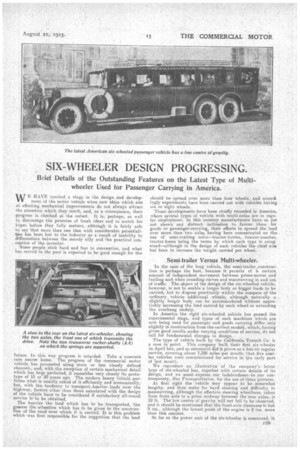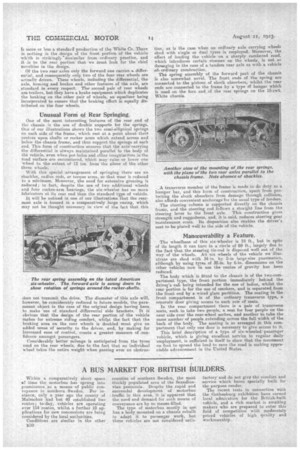SIX-WHEELER DESIGN PROGRESSING.
Page 13

Page 14

If you've noticed an error in this article please click here to report it so we can fix it.
Brief Details of the Outstanding Features on the Latest Type of Multiwheeler Used for Passenger Carrying in America.
WE HAVE reached a stage in the design and development of the motor vehicle when new ideas which aim at effecting mechanical improvements du not always attract the attention which they merit, and, as a consequence, their progress is checked at. the outset. It is, perhaps, as well to discourage the patentee of freak ideas and to scotch his hopes before they fully mature, although it is fairly safe "to say that more than one idea with considerable potentialities has been lost to the industry as a result of inability to differentiate between the merely silly and the practical con
, ception of the inventor. .
Some people stick hard and fast to convention, and what. has served in the past is expected to be good enough for The future. In this way progress is retarded. Take a concrete case nearer home. The progress of the commercial motor vehicle has proceeded along more or less closely defined channels, and, with the exception of certain mechanical detail which has begn perfected, it resembles very closely its prototype of 15 or 20 years ago. The modern heavy vehicle performs what is usually asked of it efficiently and economically, but, with the tendency to transport. heavier ,loads over the highway, factors other than those associated with the design of the vehicle have to be considered if satisfactory all-round service is" to be obtained.
The heavier the load which has to be transported, the greater the attention which has to be given to the construction of the road over which it is carried. It is this problerh which was first responsible for the suggestioa that the load
should be spread over more than four wheels, and accordingly experiments have been carried out with vehicles having six or eight wheels.
These developments have been chiefly recoeded in America, where several types of vehicle with 'multi-axles are in regular employment. In this country manufacturers have as yet ilot shown any distinct inclination to favour these for goods or passenger-carrying, their efforts to spread the load over more than two axles having been concentrated on the use of semi-trailing units—tractor-lorries, -tractor-coaches, tractor-bases; being the terms by which each type is recognised—although in the design of such vehicles the chief aint has' been to increase the weight carried per wheel.
Semi-trailer Versus Multi-wheeler.
In the case of the long vehicle, the semi-trailer/construeLion is perhaps the best, because it permits of a certain amount of independent movement between prime-mover and trailing unit when rounding curves and manceuvring in and out of traffic. The object of the deSign of the six-wheeled vehicle; however, is not to enable a longer body or bigger loads to be carried, but to dispose practically within the compass of the ordinary vehicle additional wheels, although naturally a slightly longer body can be accommodated without appreciably increasing the load carried by each wheel, or extending the overhang unduly.
In America the rigid six-wheeled vehicle has passed the experimental stage, and types of such machines which are now being used for passenger and goods carrying differ, Only slightly in construction from the earliest models, which, having given good results unde•r varying conditions of service, do not call for fundamental changes in design.
The type of vehicle built by the California Transit Co. is a case in point. This company built their first six-wheelei in April last, and so successful did it prove as a bus on regulat service, covering about 7,500 miles per month, that five similar vehicles were commissioned for service in the early part of "last month. .
We reproduce an illustration of the company's latest type of six-wheeled bus, together with certain details of its design, and we must, express • our indebtedness, to our contemporary, Bus Transportation, for the use of these pictures., At first sight the vehicle may appear to be somewhat lengthy, and thus make for hard steering and diffietilty in manoeuvring, although the effective steering wheelbase, taken from front axle to a point midway between the 'rear axles, is 18 ft. The low centre of gravity will not, fail to be observed, and it should be mentioned that the front-axle clearance -is but 9 Ins., although the lowest point of the engine is 2 ins. more than this amount.
So far as the power unit of the six-wheeler is concerned, it . )129
Is more or less a standard production of the White Co. There is nothing in the design of the front portion of -the vehicle wh'ch is strikingly dissimilar from •ordinary practice, and it is to the rear portion that we must look for the, chief novelties in the design.
Of the two rear axles only the forward one carries a differential and consequently only two of the four rear wheels are actually driven. These wheels, including the differential, the axle, housing and brakes and other features of the axle, are standard in every respect. The. second pair of rear wheels are trailers, but they have a.brake equipment which duplicates the braking on the other pair of wheels, an equalizer being incorporated to ensure that the braking effort is equally distributed on the four wheels.
Unusual Form of Rear Springing.
One of the most interesting features of the rear .end of the chassis is the use of double supports for the springs. One of our illustrations shows the two semi-elliptical springs on each side of the frame, which rest at a point about their centres upon shafts or rocker arms which extend across and below the chassis frame, and thus support the springs at each end. This form of construction ensures that the axle carrying the differential is always maintained parallel to the body of the vehicle, even when pot-holes and other irregularities in the road surface are encountered, which may raise or lower one wheel to the extent of 12 ins, from the plane of the other three wheels.
With this special -arrangement of springing there are no shackles, radius rods, or torque arms, so that Wear is reduced to a minimum. Moreover, the need for extensive greasing is reduced; in fact, despite the use of two additional wheels and four rocker-arm bearings, the six-wheeler has no more lubricators at its rear end than the standard type of vehicle. It will be noticed in one of our illustrations that the rearmost axle is housed in a comparatively large casing, which may not be thought necessary in view of the fact that this does not transmit the drive. The diameter of this axle will, however, be considerably reduced in future models, the paramount object in the ease of the original design having been to make use of standard differential side brackets. It is obvious that the design of the rear portion of the vehicle makes for extreme riding comfort, whilet the fact that the braking area on the rear wheels is doubled must give an added sense of security to the driver, and, by making for increased ease of control, create a greater measure of ,confidence amongst passengers, Considerably better mileage is anticipated from the tyres used on the rear wheels, due to the Net that no individual wheel takes the entire weight when passing ever an obstruc tion, as is the case when an ordinary axle carrying wheels shod with single or dual tyres is employed. Moreover, the effect of loading the vehicle • on a sharply cambered road, which introduces certain stresses on the wheels, is not so damaging in the case of a tandem rear axle as with a vehicle .of f ordinary construction.
The spring assembly of the forward part of the chassis is also somewhat novel. The front ends, of the spring are connected to the pistons of shock absorbers, whilst the rear ends are connected to the frame by a type dl hangar which is used on the fore end of the rear springs on the 15-cwt. White chassis.
A transverse member of the frame is made to do duty as a bumper bar,and this form of construction, apart. from protecting the shock absorbers from damage through collision, also affords convenient anchorage for the usual type of fenders. The steering column is supported directly on the chassis frame, and the steering rod follows a straight line from the steering lever to the front axle. This construction gives strength and ruggedness, and, it is said, reduces steering gear maintenance costs. Its disposition also enables the driver's seat to be placed well to the side of the vehicle.
Manceuvrability a Feature.
The wheelbase of this six-wheeler is 18 ft., but in spite of its length it can turn in a circle of 69 ft., largely due to the fact that the steering tie-rod is disputed well out of the way of the wheels. All -six wheels of the vehicle we' illusstrafe are shod with 34-in. by 5-in large-size pneumatics, although by using tyres of 32-in. by 6-in, dimensions on the other vehicles now in use the centre of gravity, has been reduced.
The body which is fitted to the chassis is of the two-compartment type, the front portion immediately behind the drivee's cab being intended for the use of ladies, whilst the rear portion is for the use of smokers, and is separated from the front end by a wired glass partition. The seating in the front compartment is of the ordinary transverse type, a separate doer giving access to each row of seats. In the rear compartment there is a pair of transverse seats, each to take two people, a seat for four people on the near side over the rear-wheel arches, and another to take the same number of people extending across the full width of the back of the body. The seating is so arranged in this compartment that only one door is necessary to give access to it. This brief description of a type of six-wheeled passenger vehicle, which is giving excellent service in regular daily employment, is sufficient in itself to show that the movement on foot to spread the load to save the road is making appreciable advancement. in the United States.




























